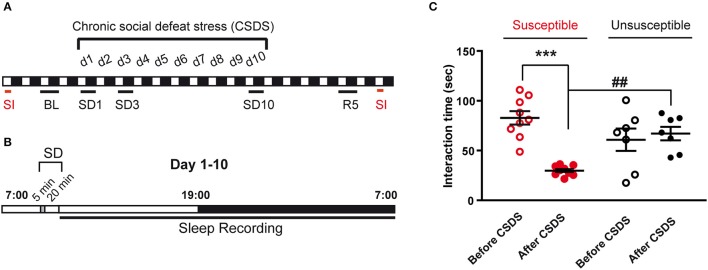Figure 1.
Experimental timeline and behavioral consequences of the chronic social defeat stress protocol. (A) Mice were exposed to chronic social defeat stress (CSDS) for 10 days (d1–d10). Analyzed polysomnographic recordings are indicated by black bars above the respective recording days (BL, SD1, SD3, SD10). As control, baseline (BL) recordings started 2 days before CSDS (24 h starting at 7 a.m.). Recordings were also collected on recovery day 5 (R5; 24 h starting at 7 a.m.). Mice were assessed for social avoidance behavior in the social interaction test (SI, red bars) before and after 10-day CSDS. (B) The CSDS paradigm consists in exposing mice to 5 min of physical defeat at 9:30 a.m. followed by 20 min of protected sensory contact with a trained CD1 aggressor male mouse. Mice were then placed back in their home cage and ploysomnographic recordings were started until the following day (7 a.m.). (C) Time in the interaction zone before (open circles) and after (filled circles) the 10-day CSDS paradigm. Mice were first allowed to explore for 2.5 min an arena in which an empty perforated plexiglass cage was placed on the middle of one wall. Then, an unfamiliar CD-1 mouse was introduced into the empty cage for 2.5 min (“Target” condition). Susceptible mice (red, n = 9) were selected a posteriori as follow: (1) a social interaction ratio [(interaction time, condition “Target” after the CSDS)/(interaction time, condition “Target” before the CSDS)] smaller than 1 and (2) an interaction time with target <45 s. Mice that did not reach these criteria were included in the unsusceptible group (black, n = 7). Data are expressed as means ± SEM of nine susceptible mice and seven unsusceptible mice. ***P < 0.001, significantly different from the control condition (before the CSDS paradigm). ##P < 0.01, susceptible vs. unsusceptible mice (for statistics see Table S1).

